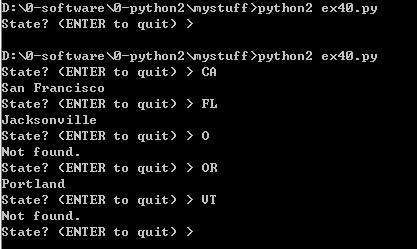习题 40: 字典, 可爱的字典
接下来我要教你另外一种让你伤脑筋的容器型数据结构,因为一旦你学会这种容器,你将拥有超酷的能力。这是最有用的容器:字典(dictionary)。
Python 将这种数据类型叫做 “dict”,有的语言里它的名称是 “hash”。这两种名字我都会用到,不过这并不重要,重要的是它们和列表的区别。你看,针对列表你可以做这样的事情:
1 >>> things = ['a', 'b', 'c', 'd'] 2 >>> print things[1] 3 b 4 >>> things[1] = 'z' 5 >>> print things[1] 6 z 7 >>> print things 8 ['a', 'z', 'c', 'd'] 9 >>>
你可以使用数字作为列表的索引,也就是你可以通过数字找到列表中的元素。而 dict 所作的,是让你可以通过任何东西找到元素,不只是数字。是的,字典可以将一个物件和另外一个东西关联,不管它们的类型是什么,我们来看看:
1 >>> stuff = {'name': 'Zed', 'age': 36, 'height': 6*12+2} 2 >>> print stuff['name'] 3 Zed 4 >>> print stuff['age'] 5 36 6 >>> print stuff['height'] 7 74 8 >>> stuff['city'] = "San Francisco" 9 >>> print stuff['city'] 10 San Francisco 11 >>>
你将看到除了通过数字以外,我们还可以用字符串来从字典中获取 stuff ,我们还可以用字符串来往字典中添加元素。当然它支持的不只有字符串,我们还可以做这样的事情:
1 >>> stuff[1] = "Wow" 2 >>> stuff[2] = "Neato" 3 >>> print stuff[1] 4 Wow 5 >>> print stuff[2] 6 Neato 7 >>> print stuff 8 {'city': 'San Francisco', 2: 'Neato', 9 'name': 'Zed', 1: 'Wow', 'age': 36, 10 'height': 74} 11 >>>
在这里我使用了两个数字。其实我可以使用任何东西,不过这么说并不准确,不过你先这么理解就行了。
当然了,一个只能放东西进去的字典是没啥意思的,所以我们还要有删除物件的方法,也就是使用 del 这个关键字:
1 >>> del stuff['city'] 2 >>> del stuff[1] 3 >>> del stuff[2] 4 >>> stuff 5 {'name': 'Zed', 'age': 36, 'height': 74} 6 >>>
接下来我们要做一个练习,你必须非常仔细,我要求你将这个练习写下来,然后试着弄懂它做了些什么。这个练习很有趣,做完以后你可能会有豁然开朗的感觉。

1 cities = {'CA': 'San Francisco', 'MI': 'Detroit', 2 'FL': 'Jacksonville'} 3 4 cities['NY'] = 'New York' 5 cities['OR'] = 'Portland' 6 7 def find_city(themap, state): 8 if state in themap: 9 return themap[state] 10 else: 11 return "Not found." 12 13 # ok pay attention! 14 cities['_find'] = find_city 15 16 while True: 17 print "State? (ENTER to quit)", 18 state = raw_input("> ") 19 20 if not state: break 21 22 # this line is the most important ever! study! 23 city_found = cities['_find'](cities, state) 24 print city_found
Warning
注意到我用了 themap 而不是 map 了吧?这是因为 Python 已经有一个函数称作 map 了,所以如果你用 map 做变量名,你后面可能会碰到问题。
你应该看到的结果

加分习题
- 在 Python 文档中找到 dictionary (又被称作 dicts, dict)的相关的内容,学着对 dict 做更多的操作。
- 找出一些 dict 无法做到的事情。例如比较重要的一个就是 dict 的内容是无序的,你可以检查一下看看是否真是这样。
- 试着把 for-loop 执行到 dict 上面,然后试着在 for-loop 中使用 dict 的 items() 函数,看看会有什么样的结果。
习题练习
Python中的字典:
Python种的字典由键(key)和值(value)组成。键(key)相当于我们日常生活中字典的页码,是一种索引或者说地址,每一个键都对应一个值。键和值实际组成了一个散列函数。
下表是字典的常用操作:
| Operation | Result |
|---|---|
| len(a) | the number of items in a 得到字典中元素的个数 |
| a[k] | the item of a with key k 取得键K所对应的值 |
| a[k] = v | set a[k] to v 设定键k所对应的值成为v |
| del a[k] | remove a[k] from a 从字典中删除键为k的元素 |
| a.clear() | remove all items from a 清空整个字典 |
| a.copy() | a (shallow) copy of a 得到字典副本 |
| k in a | True if a has a key k, else False 字典中存在键k则为返回True,没有则返回False |
| k not in a | Equivalent to not k in a 字典中不存在键k则为返回true,反之返回False |
| a.has_key(k) | Equivalent to k in a, use that form in new code 等价于k in a |
| a.items() | a copy of a’s list of (key, value) pairs 得到一个键值的list |
| a.keys() | a copy of a’s list of keys 得到键的list |
| a.update([b]) | updates (and overwrites) key/value pairs from b 从b字典中更新a字典,如果键相同则更新,a中不存在则追加 |
| a.fromkeys(seq[, value]) | Creates a new dictionary with keys from seq and values set to value 创建一个新的字典,键来自seq,值对应键对应的值 |
| a.values() | a copy of a’s list of values 得到字典值的副本 |
| a.get(k[, x]) | a[k] if k in a, else x 得到a[k],若存在返回x |
| a.setdefault(k[, x]) | a[k] if k in a, else x (also setting it) 得到a[k],若不存在返回x,并设定为x |
| a.pop(k[, x]) | a[k] if k in a, else x (and remove k) 弹出a[k],若不存在则返回x,同时将删除k键 |
| a.popitem() | remove and return an arbitrary (key, value) pair 弹出a中对象的键和值,并删除弹出的键和值 |
| a.iteritems() | return an iterator over (key, value) pairs 返回a中所有对象(键和值) |
| a.iterkeys() | return an iterator over the mapping’s keys 返回a中所有键(索引) |
| a.itervalues() | return an iterator over the mapping’s values 返回a中所有值 |
